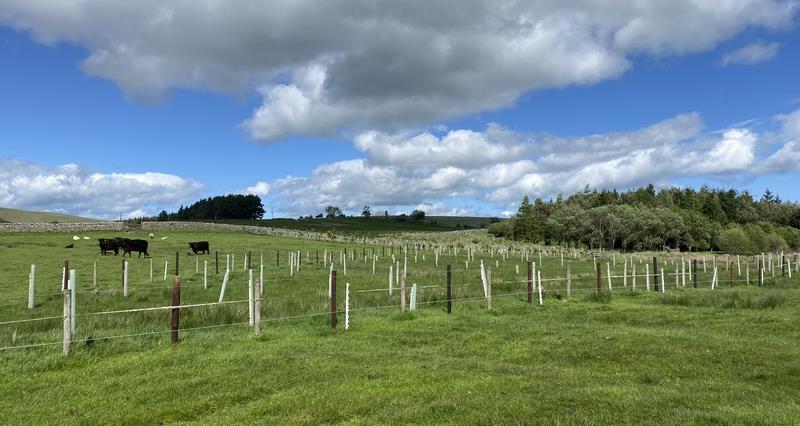Usually, I work with smallholder farmers in Tanzania, so when I had the chance to work much closer to home I jumped at it. Not only did I get to visit farms across such a beautiful area, but I got a crash course in the English farming system, our small but expanding agroforestry sector and how this plays out on the ground for local farmers.
Agroforestry is a buzz word that is gaining more attention in the farming industry, but there is a lack of scientific research into what that means, and the benefits it may provide for farmers in the North East. According to Defra, agroforestry is the intentional integration of trees on agricultural land (arable and/or livestock), to provide income and a range of social and environmental benefits. Types of agroforestry include silvoarable (trees and crops), silvopasture (trees and livestock), hedgerows, riparian forest buffers and shelter belts.
In a collaboration between Newcastle University, the Forestry Commission, and the Great Northumberland Forest, we set about asking farmers how they see agroforestry in their farming system to ensure that their views/needs are at the forefront of future studies. Specifically, we explored whether farmers are considering using agroforestry practices, what challenges and opportunities they face in doing so, and what support is needed to make agroforestry viable.
Out in the field
In May and June, I visited 13 farms across Northumberland, sitting down with the farmer for an informal interview before having a tour of the farm, going to areas identified as potential tree planting sites. We visited one arable, eight livestock, two mixed, and two dairy farms that ranged from 128 to 1000 hectares. Two were within Northumberland National Park.
We interviewed two women, two couples and nine men – two farm managers, three tenants and eight owner occupiers. At the start of every visit I emphasised that the aim was to understand the context of how individual farms operate, how farmers envision their farms in the future and whether trees play a role in that.
Key findings
We found that agroforestry can be seen as a part of integrated farm management, linking to strategies such as reducing farm inputs and converting to rotational grazing systems for soil and grass health and a longer window for outside grazing.
Potential benefits for farm productivity and resilience – through better livestock health from enhanced shade, shelter and nutrition – were the key drivers. Participants had broad definitions of agroforestry and were usually interested in multiple types of tree planting that fit the specific context within the farm. They preferred tree and livestock systems, often parkland-style low-density
planting with native broadleaf species, but were also interested in expanding woodland areas, shelter belts and connecting hedgerows.
They recognised broad environmental benefits such as increasing connectivity and exhibited a sense of land stewardship. Interestingly, none considered a direct economic benefit from their trees (e.g. timber or fruit) usually because of the small-scale nature of the planting or lack of a local market.
What support is required?
It is clear that our farmers are interested in agroforestry but are impeded by a lack of funding and tailored advice.
They wanted funding to be flexible and encourage innovation, adding that agri-environment schemes can lock land into management regimes that prevent this. Some saw prospects in private sector financing for the future.
They also wanted access to tailored advice on issues such as what and where to plant, sapling protection from livestock, deer and hares, and management methods. Some mentioned issues associated with top-down advice that doesn’t reflect their circumstances or motivations.
Find out more
For more information on the project and its outputs visit: Agroforesty in the UK | TROPS – TROPical landScapes
